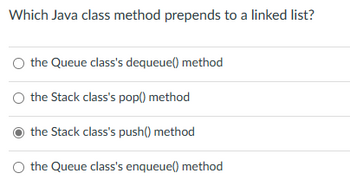
Database System Concepts
7th Edition
ISBN: 9780078022159
Author: Abraham Silberschatz Professor, Henry F. Korth, S. Sudarshan
Publisher: McGraw-Hill Education
expand_more
expand_more
format_list_bulleted
Question
I need help with this Java problem to output as it's explained in this image below:

Transcribed Image Text:Which Java class method prepends to a linked list?
the Queue class's dequeue() method
the Stack class's pop() method
the Stack class's push() method
O the Queue class's enqueue() method
SAVE
AI-Generated Solution
info
AI-generated content may present inaccurate or offensive content that does not represent bartleby’s views.
Unlock instant AI solutions
Tap the button
to generate a solution
to generate a solution
Click the button to generate
a solution
a solution
Knowledge Booster
Similar questions
- I needed some help with this java homework assignement. We use eclipse. CIS365 Hw1: Count LetterWrite a Java program (CountLetter.java). Input a sentence from keyboard. Print out how many letters "a", "e", "o" and the percentage of each letter in the whole sentence. Please enter a sentence, ended by period '.': (5 points)Sentence.... (10 points)There are 20 letters (10 points)a: 1, 5% (20 points)e: 0, 0% (20 points)o: 4, 20% (20 points)arrow_forwardTHIS IS MEANT TO BE IN JAVA. What we've learned so far is variables, loops, and we just started learning some array today. The assignment is to get an integer from input, and output that integer squared, ending with newline. But i've been given some instructions that are kind of confusing to me. Please explain why and please show what the end result is. Here are some extra things i've been told to do with the small amount of code i've already written... Type 2 in the input box, then run the program so I can note that the answer is 4 Type 3 in the input box instead, run, and note the output is 6. Change the output statement to output a newline: System.out.println(userNumSquared);. Type 2 in the input box Change the program to use * rather than +, and try running with input 2 (output is 4) and 3 (output is now 9, not 6 as before). This is what I have so far... import java.util.Scanner; public class NumSquared {public static void main(String[] args) {Scanner scnr = new…arrow_forwardImplement the problem below in Python using mpi4py. Submit the code of your program and a brief report. The report should describe the design of your program, and demonstrate the results of running your program. n-body solver. Implement a parallel n-body solver with n = 10 particles. You may randomly generate the masses, initial velocities, and initial positions of all particles at the beginning. Compute the positions of all particles after 1 second. Compare the results by using 0.1s, 0.01s, and 0.001s as the time in each timestep, respectively.arrow_forward
- Please use java to complete this programarrow_forwardWrite a Java program that displays the prime numbers between A and Barrow_forwardInstead of using: print(f"You should be spending {hours_inhome} hours on homework outside of class every week") for a beginner in python what is an alternative to using "f" and the { } signs for when you type in print. Also can you explain what the f means and what "{ }" these signs are?arrow_forward
- Use Java language and the last digit of ID is a 7arrow_forwardFor this task, save your work in Roman.java You surely have encountered Roman numerals: I, II, III, XXII, MCMXLVI, etc. Roman numerals are represented by repeating and combing the following seven characters: I = 1, V = 5, X = 10, L = 50, C = 100, D = 500, M = 1000. To understand how they must be composed, we borrow the following excerpt from Dive Into Python: • Characters are additive. I is 1, II is 2, and III is 3. VI is 6 ("5 and 1"), VII is 7, and VIII is 8. ⚫ The tens characters (I, X, C, and M) can be repeated up to three times. At 4, you need to subtract from the next highest fives character. You can't represent 4 as IIII; instead, it is represented as IV ("1 less than 5"). The number 40 is written as XL (10 less than 50), 41 as XLI, 42 as XLII, 43 as XLIII, and then 44 as XLIV (10 less than 50, then 1 less than 5). • Similarly, at 9, you need to subtract from the next highest tens character: 8 is VIII, but 9 is IX (1 less than 10), not VIIII (since the I character cannot be…arrow_forwardwrite a java code to print the following gridarrow_forward
arrow_back_ios
arrow_forward_ios
Recommended textbooks for you
 Database System ConceptsComputer ScienceISBN:9780078022159Author:Abraham Silberschatz Professor, Henry F. Korth, S. SudarshanPublisher:McGraw-Hill Education
Database System ConceptsComputer ScienceISBN:9780078022159Author:Abraham Silberschatz Professor, Henry F. Korth, S. SudarshanPublisher:McGraw-Hill Education Starting Out with Python (4th Edition)Computer ScienceISBN:9780134444321Author:Tony GaddisPublisher:PEARSON
Starting Out with Python (4th Edition)Computer ScienceISBN:9780134444321Author:Tony GaddisPublisher:PEARSON Digital Fundamentals (11th Edition)Computer ScienceISBN:9780132737968Author:Thomas L. FloydPublisher:PEARSON
Digital Fundamentals (11th Edition)Computer ScienceISBN:9780132737968Author:Thomas L. FloydPublisher:PEARSON C How to Program (8th Edition)Computer ScienceISBN:9780133976892Author:Paul J. Deitel, Harvey DeitelPublisher:PEARSON
C How to Program (8th Edition)Computer ScienceISBN:9780133976892Author:Paul J. Deitel, Harvey DeitelPublisher:PEARSON Database Systems: Design, Implementation, & Manag...Computer ScienceISBN:9781337627900Author:Carlos Coronel, Steven MorrisPublisher:Cengage Learning
Database Systems: Design, Implementation, & Manag...Computer ScienceISBN:9781337627900Author:Carlos Coronel, Steven MorrisPublisher:Cengage Learning Programmable Logic ControllersComputer ScienceISBN:9780073373843Author:Frank D. PetruzellaPublisher:McGraw-Hill Education
Programmable Logic ControllersComputer ScienceISBN:9780073373843Author:Frank D. PetruzellaPublisher:McGraw-Hill Education

Database System Concepts
Computer Science
ISBN:9780078022159
Author:Abraham Silberschatz Professor, Henry F. Korth, S. Sudarshan
Publisher:McGraw-Hill Education

Starting Out with Python (4th Edition)
Computer Science
ISBN:9780134444321
Author:Tony Gaddis
Publisher:PEARSON

Digital Fundamentals (11th Edition)
Computer Science
ISBN:9780132737968
Author:Thomas L. Floyd
Publisher:PEARSON

C How to Program (8th Edition)
Computer Science
ISBN:9780133976892
Author:Paul J. Deitel, Harvey Deitel
Publisher:PEARSON

Database Systems: Design, Implementation, & Manag...
Computer Science
ISBN:9781337627900
Author:Carlos Coronel, Steven Morris
Publisher:Cengage Learning

Programmable Logic Controllers
Computer Science
ISBN:9780073373843
Author:Frank D. Petruzella
Publisher:McGraw-Hill Education